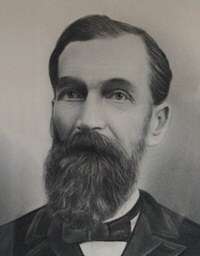Cyrus Gates

Cyrus Gates (July 27, 1802 - December 11, 1891) was an abolitionist, cartographer, and owner of the Cyrus Gates Farmstead in Maine, New York.
Early life
Cyrus Gates was born to Russell and Ester (Briggs) Gates in Four Corners, Maine, New York Today this area is where Corson and Old Nanticoke Roads intersect. Under the Boston Purchase or Boston Ten Townships, Cyrus' father and mother had migrated from the East Haddam, Connecticut area in the early 1790s. Russell and his brother Alfred trail blazed the road from Union Center to Nanticoke, NY in order to gain access to their newly purchased property. Cyrus would follow his father by continuing to farm and staying on the land. Cyrus would serve as a deacon in the Maine Baptist church, as he maintained a proactive and sacrificial abolitionist stance.
The Underground Railroad
Even before Cyrus built his Greek Revival home in 1848 he had taken to harboring runaway slaves. When Cyrus built his new home in 1848 he continued in his activism. He built a secret access door to a hidden part of the attic. If ever needed, this hiding space would add to the safety of runaway slaves that he was harboring at his home.
Occupation
Cyrus' main occupation was that of a cartographer and surveyor-and would map 15 counties for the state of New York. Cyrus also served for several years as the local Justice of the Peace in the then newly formed Town of Maine. Although Cyrus did not farm as vigorously as his father had, he was still able to produce: apples, maple sugar, honey, as well as other standard farm produce.
Family life
In 1828 Cyrus married Arabella Leadbetter they had four children: Livingston-1829, who would serve in the U.S. Army during the Civil war and then move on to Wisconsin. Byron-1832, (who would marry Lydia Buck-sister of Daniel W. Buck-Mayor of Lansing, MI), Aravesta-1836, and Eugene-1843 who would serve in the U. S. Navy on the USS Dictator (1863) during the Civil War.
The Cyrus Gates Farmstead
In 1848 when Cyrus was 45 years old he began building a Greek inspired farmhouse. He hired a man from New York City named Charles Yarrington to build it. By the standards of the day and Cyrus' rural location, the style of the house would be considered quite extravagant and over-done for a stick frame farmhouse. In fact, the locals feeling somewhat miffed by Cyrus' use of an out of town builder, called the new house "Gates' white elephant." Construction on the building commenced in January 1848.[1] Great x2 Granddaughter of Cyrus-Louis Gates-Gunsalus says that the house was completed enough to be lived in by the end of that year. The inside carpentry and other finish work of the house would not be completed until 1851.
References
- ↑ Luther, Roger (February 7, 2008). "Freedom is Where I'm Going: Cyrus Gates' Station on the Underground Railroad". Treasures of the Tier. Binghamton Press and Sun Bulletin.
- "National Register Information System". National Register of Historic Places. National Park Service. 2009-03-13.
- Gunsalus, Paul and Louise, A Record of the Descendants of Thomas and Anna Rowley Leadbetter, Maine, NY 1980.
- LaFrank, Kathleen (July 1998). "National Register of Historic Places Registration: Cyrus Gates Farmstead". New York State Office of Parks, Recreation and Historic Preservation. Retrieved 2009-11-01. See also: "Accompanying six photos"
- Woodward, Shirley L., A Short History of Maine, New York, 1973
- http://www.wpcsd.org/education/components/scrapbook/default.php?sectiondetailid=2931
- Descendants of George Gates. Ancestry.com
- http://www.wpcsd.org/education/components/links/links.php?sectiondetailid=2928&
- Historic American Buildings Survey 1963. Library of Congress